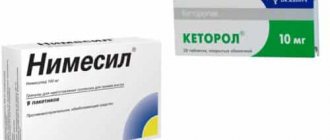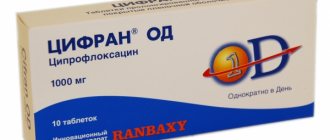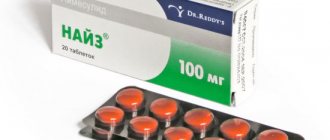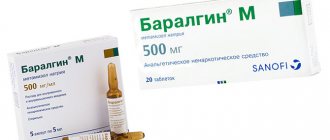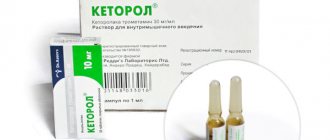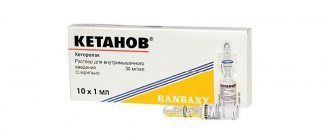Pain management is the most common process in all of medicine. There are many ways to relieve pain of all kinds (from using any cold object to surgical methods), but one of the simplest, most common and effective is medication, namely by taking pills.
Today, drugs such as Ketorol and Ketonal are extremely popular. These drugs can be used both in tablet form and in injection form, however, tablets, due to their ease of use, high availability and equally high effectiveness, are replacing the injection forms of these drugs in terms of prevalence.
Every person should clearly know that despite their names being very similar to each other and the general class of medications, Ketonal and Ketorol are different drugs. This difference needs to be understood in detail.
Characteristics of Ketonal
This is a non-narcotic, non-hormonal drug, characterized by antipyretic, anti-inflammatory and analgesic properties. It helps relieve moderate and severe pain of various origins, for example, with colic, neuralgia, myalgia, radiculitis, osteoarthritis, spondylitis, arthritis, etc.
Dosage forms of Ketonal:
- pills;
- gel;
- cream;
- rectal suppositories;
- solution in ampoules for intravenous or intramuscular administration;
- capsules.
The main active component of the drug is ketoprofen. This substance belongs to the group of nonsteroidal anti-inflammatory drugs (NSAIDs). A distinctive feature of the drug is the provision of a wide range of analgesic effects, distributed to the peripheral and central nerve fibers that are responsible for the perception of pain impulses. Therefore, Ketonal is often used for pain in joints, muscles, and ligaments. The drug reduces inflammatory reactions, which helps relieve pain in joint diseases and relieves morning stiffness.
Tablets, injections, suppositories and capsules are prescribed for the treatment of degenerative or inflammatory diseases of cartilage, ligaments, muscles, joints and bones:
- rheumatoid arthritis;
- glenohumeral syndrome;
- rheumatism;
- gout and pseudogout;
- osteochondrosis;
- osteoarthritis;
- arthrosynovitis;
- periarthritis;
- polyarthritis;
- reactive arthritis;
- ankylosing spondylitis;
- psoriatic arthritis.
To relieve pain, doctors often prescribe drugs such as Ketonal or Ketorol.
In addition, these dosage forms are prescribed to relieve severe or moderate pain in the following diseases and conditions:
- phlebitis;
- lumbago;
- lumbodynia;
- sciatica;
- radiculitis;
- neuralgia;
- myalgia;
- headache;
- bursitis;
- tendinitis;
- lymphadenitis and lymphangitis;
- pain after operations, injuries, during menstruation and malignant tumors.
Gel and ointment are indicated in the following cases:
- periarthritis and rheumatoid arthritis;
- neuralgia;
- myalgia;
- bursitis, tendinitis;
- osteoarthritis;
- reactive arthritis;
- psoriatic arthritis;
- ankylosing spondylitis;
- ruptures of tendons and muscle ligaments, sprains, bruises of ligaments and muscles, injuries to the musculoskeletal system;
- radiculitis.
Contraindications for Ketonal include:
- intolerance to drugs of the NSAID group;
- bleeding disorders;
- exacerbation of inflammatory bowel diseases (enteritis, Crohn's disease, etc.);
- exacerbation of a stomach or duodenal ulcer;
- chronic digestive disorders (constipation, diarrhea, flatulence, etc.);
- bleeding of any location (uterine, gastrointestinal, etc.);
- coronary artery bypass grafting performed less than 2 months ago;
- heart failure;
- progressive kidney disease;
- severe liver or kidney failure;
- third trimester of pregnancy;
- breastfeeding;
- children under 15 years of age.
We recommend reading: Compatibility of Dimexide and Novocaine
Contraindications for Ketonal include: intolerance to NSAIDs, blood clotting disorders.
Cream and gel should not be applied to wounds on the skin (wetting dermatitis, eczema, open wound, etc.).
Ketonal DUO in the treatment of pain syndrome
Pain is the most common symptom of a wide variety of diseases. The International Association for the Study of Pain (IASP) defines pain as an unpleasant sensation and emotional experience associated with actual or potential tissue damage or described in terms of such damage [1]. Pain is heterogeneous, has many characteristics and occurs due to various pathophysiological mechanisms underlying a particular disease. That is why, for successful treatment of pain syndrome, drug therapy should be selected in accordance with the type of pain and the characteristics of its pathogenesis.
Classifications of pain syndrome
In medical practice, acute and chronic pain are distinguished. Acute pain is caused by tissue damage and decreases as it heals, is characterized by a sudden onset, short duration, clear localization and, as a rule, is a symptom of some disease. Acute pain performs a signaling function, warning of danger and ensuring the mobilization of the body's defenses aimed at eliminating the damaging factor. Pain is called chronic if it persists after the healing process is complete. There is still no consensus on the time criterion for pain chronicization, that is, it is unclear at what point in time chronicization occurs. According to the International Association for the Study of Pain, pain is considered chronic if it lasts at least 3 months, and in accordance with the criteria of DSM-IV (Diagnostic and Statistical Manual of mental disorders) - at least 6 months. In any case, chronic pain is not accompanied by signs characteristic of acute pain, does not have a protective function and becomes the cause of suffering for the patient. However, the main difference between chronic pain and acute pain is not the time factor, but qualitatively different neurophysiological, psychophysiological and clinical relationships. According to the generally accepted pathophysiological classification, pain is divided into nociceptive, neuropathic and dysfunctional.
Nociceptive pain
occurs when peripheral pain receptors - “nociceptors”, are irritated, localized in almost all organs and systems (coronary syndrome, pleurisy, pancreatitis, gastric ulcer, renal colic, articular syndrome, damage to the skin, ligaments, muscles, etc.) due to damage and /or inflammation of soft tissues. With this type of pain, the factor that caused it is usually obvious, the pain is well localized (nociceptive pain is usually localized in the area of damage). When describing nociceptive pain, patients most often use the terms “squeezing”, “aching”, “pulsating”, “cutting”. In the treatment of nociceptive pain, a good therapeutic effect can be obtained by prescribing simple analgesics and nonsteroidal anti-inflammatory drugs (NSAIDs). When the cause is eliminated (cessation of irritation of the “nociceptors”), nociceptive pain goes away [2].
Neuropathic pain
occurs due to damage to various parts (peripheral and central) of the somatosensory nervous system [2]. The causes of neuropathic pain can be damage to the afferent somatosensory system at any level, from peripheral sensory nerves to the cerebral cortex, as well as disturbances in descending antinociceptive systems. This type of pain occurs in diabetic polyneuropathy, postherpetic and trigeminal neuralgia, post-stroke condition, and phantom pain. The general characteristics of neuropathic pain are: duration, persistent nature, variety of sensory manifestations (hypersthesia, hyperpathia, allodynia, loss of various types of sensitivity), combination with autonomic disorders (hyperemia or decreased blood flow, hyper- or anhidrosis in the pain area) and motor disorders. Standard analgesics and NSAIDs are ineffective in the treatment of neuropathic pain [3].
As a rule, in most cases (radiculopathy, carpal tunnel syndrome, cancer, complex regional pain syndrome), pain is of a mixed nature, including both nociceptive and neuropathic components [2]. In the treatment of mixed pain, various therapeutic approaches are used. The peculiarity of dysfunctional pain is that the examination fails to identify the cause of the pain or organic diseases that could explain the origin of the pain. Among the main reasons contributing to the development of this type of pain are not organic pathology, but psychological and social factors. Typical examples of dysfunctional pain are fibromyalgia, tension headaches, and psychogenic pain (somatoform disorders) [4]. Another characteristic of the pain syndrome that influences the choice of analgesic therapy is its intensity. It is generally accepted to divide pain into mild, moderate and severe.
Pain therapy
Currently, non-steroidal anti-inflammatory drugs occupy a leading position in the treatment of pain syndrome. Due to their mechanism of action, NSAIDs have proven themselves to be best for acute nociceptive pain of mild to moderate intensity. The advantage of NSAIDs is that they have not only an analgesic but also an anti-inflammatory effect. The therapeutic effects of NSAIDs are based on reducing the synthesis of prostaglandins from arachidonic acid through inhibition of the enzyme cyclooxygenase (COX). There are two isoforms of COX: COX-1 is constantly present in all tissues, COX-2 is synthesized against the background of inflammation. Of particular interest are new dosage forms of NSAIDs that make it possible to maintain a pronounced anti-inflammatory and analgesic effect and at the same time reduce the degree of undesirable effects on the gastrointestinal tract [5–7].
Ketonal DUO: advantages of the new form
New NSAIDs include Ketonal (Lek, Slovenia), the main active ingredient of which is ketoprofen. According to its chemical structure, ketoprofen belongs to the group of propionic acid derivatives. It non-selectively inhibits the enzymes COX-1 and COX-2 and, partially, lipoxygenase. The powerful anti-inflammatory and analgesic effect of ketoprofen is due to the fact that it has both a peripheral and central mechanism of action, therefore it is used even in cases of severe pain. In peripheral tissues, ketoprofen suppresses the synthesis of prostaglandins, stabilizes lysosomal membranes, and has distinct anti-bradykinin activity. Due to its high lipophilicity, the ketoprofen molecule penetrates the blood-brain barrier, where it realizes its central effect: it reduces the synthesis of prostaglandins and blocks excitatory amino acid receptors in the spinal cord. Ketonal DUO is an innovative form of NSAID. It differs from both regular and extended-release forms in the way it releases the active substance. Modified release capsules contain two types of pellets: white (about 60% of the total) and yellow coated pellets (about 40%). Ketoprofen is quickly released from white pellets and slowly from yellow ones, which determines the combination of rapid and prolonged action of the drug [8]. One capsule of Ketonal DUO contains 150 mg of ketoprofen, which does not exceed the standard daily dose of the drug. Ketonal DUO modified release capsules have the following advantages:
- contain the optimal daily dose of ketoprofen, which allows you to reduce the frequency of taking the drug to once a day, which is convenient to use;
- provide a more stable concentration of the drug in the blood over a 24-hour interval;
- minimize the irritating effect of the drug on the gastrointestinal tract;
- increase patient compliance due to a single daily dose of the drug.
Ketonal DUO: proven effectiveness
Currently, extensive experience has been accumulated in the use of ketoprofen in various clinical situations. A double-blind, placebo-controlled study conducted by R. Lange, R. Lentz (1995) in parallel groups in 345 patients showed the advantage of ketoprofen for the relief of acute pain over drugs such as naproxen and ibuprofen [9]. Ketoprofen is successfully used for “low back pain” syndrome. In a randomized, double-blind, multicenter study by H. Zippel, A. Wagenitz (2007) involving 370 patients, ketoprofen at a dose of 50 mg 2 times a day intramuscularly was more effective than diclofenac at a dose of 75 mg 2 times a day intramuscularly. Patients receiving ketoprofen showed a more pronounced reduction in pain with good tolerability [10]. B.R. Gelfand et al. (2002) compared the analgesic effectiveness of ketoprofen and ketorolac in patients in the postoperative period. The results of the study showed that the severity of pain on the visual analogue scale was significantly lower in the group receiving ketoprofen compared to the group of patients taking ketorolac. Adverse events were observed in 4% of patients taking ketoprofen and in 14% of patients taking ketorolac. No serious adverse events were observed in patients receiving ketoprofen as analgesic therapy [11].
Ketoprofen is widely used abroad for analgesia in the postoperative period. In the work of F. Aubrun et al. (2000) showed that the administration of ketoprofen leads to a reduction in the dose of morphine in the postoperative period by 33% [12]. Ketoprofen has pronounced anti-inflammatory and analgesic effectiveness in the treatment of rheumatic diseases. Ketoprofen shows an effectiveness that exceeds that of diclofenac, with better tolerability. In a study by I. Jokhio (1998), with a good analgesic effect in 87% of patients taking ketoprofen, good tolerability was noted in 72%, while among patients taking diclofenac, good tolerability was observed in only 50% of cases [13]. A. Calin et al. (1977) found that ketoprofen at a dose of 150–300 mg per day for 3 months also showed better efficacy and tolerability compared with ibuprofen at a daily dose of 1200–2400 mg in patients with rheumatoid arthritis in a double-blind, controlled study in parallel groups [14 ].
In Russia, in 2012, a multicenter (including 10 cities of the Russian Federation) open study was conducted to evaluate the effectiveness and safety of the use of the drug Ketonal DUO in the treatment of dorsalgia. A total of 349 patients took part in the study and received Ketonal DUO at a dose of 150 mg/day for 7 days. The data obtained demonstrated a significant reduction in the level of back pain both at rest and during movement (p
Conclusion
Thus, the powerful analgesic and anti-inflammatory effect of the drug Ketonal DUO, as well as proven good tolerability, combined with the convenience of a single dose, allow us to recommend the drug for use in the treatment of a wide range of pain syndromes.
Characteristics of Ketorol
This is a powerful analgesic with a fairly weak antipyretic and anti-inflammatory effect. It is most often prescribed to relieve moderate to severe pain, especially associated with injuries. The drug helps if the back hurts or a person suffers from migraines, neuralgia, radiculitis. Dosage forms: tablets, gel, solution for intravenous and intramuscular administration. The main component is ketorolac.
The mechanism of action of the drug is based on its ability to block the work of cyclooxygenase, a special enzyme that converts arachidonic acid into prostaglandins. These are substances that provoke the development of pain, inflammation and an increase in body temperature. Ketorol thins the blood well, so it is prescribed with caution to people suffering from diseases associated with bleeding (stomach ulcers, hemophilia, etc.).
Indications for use of the drug:
- injuries (synovitis, tendonitis, bursitis, ligament damage, soft tissue inflammation, bruises, etc.);
- radiculitis;
- neuralgia;
- pain in joints and muscles;
- osteoarthritis;
- pain syndrome after injury.
The analgesic effect of the drug is aimed at relieving pain, but does not eliminate its cause and does not cure the underlying disease. An overdose of the gel is impossible, but if it accidentally gets into the stomach, for example, when licked from hands, lips, etc., then you need to induce vomiting and take some kind of sorbent (activated carbon, Enterosgel, Polysorb).
Overdose with injection solution and tablets is possible. It manifests itself as symptoms of poisoning: nausea, vomiting, abdominal pain. In addition, other undesirable effects of the body may be observed:
- from the gastrointestinal tract: pancreatitis, enlarged liver, hepatitis, jaundice, ulcers and erosions of the stomach, constipation, flatulence, stomatitis, diarrhea;
- from the urinary system: edema, nephritis, decrease or increase in the amount of urine, frequent urination, hemolytic uremic syndrome, azotemia, hematuria, lower back pain, acute renal failure;
- from the respiratory system: laryngeal edema, rhinitis, dyspnea, bronchospasm;
- from the central nervous system: headache, mood swings, hyperactivity, aseptic meningitis, drowsiness, dizziness, blurred vision, ringing in the ears, hearing impairment, psychosis, depression, hallucinations, anxiety;
- from the cardiovascular system: fainting, pulmonary edema, increased blood pressure;
- from the blood system: bleeding from the rectum, nose, surgical wound, leukopenia, eosinophilia;
- on the skin: rash, Lyell's syndrome, Stevens-Johnson syndrome, urticaria, exfoliative dermatitis, purpura;
- allergic reactions: itching, anaphylactic shock, shortness of breath, swelling of the eyelids, dyspnea, heaviness in the chest.
We recommend reading: Comparison of Arthra and Arthra Forte
Ketorol helps if the back hurts or a person suffers from migraines, neuralgia, radiculitis.
Ketorol is contraindicated in the following cases:
- “aspirin” asthma;
- hemorrhagic diathesis and stroke;
- renal and liver failure;
- decreased blood clotting;
- peptic ulcers;
- ulcers and erosions of the digestive organs;
- dehydration;
- hypovolemia;
- angioedema (in the past);
- bronchospasm;
- impaired hematopoiesis in the bone marrow;
- high risk of bleeding;
- simultaneous use with other NSAIDs;
- children under 16 years of age;
- pregnancy, breastfeeding;
- intolerance to the components of the drug.
Ketorol
Ketorol is a drug belonging to the class of NSAIDs (non-steroidal anti-inflammatory drugs). Kerolol is also known by the name of its active ingredient (Ketorolac). Between Ketoro and Ketorolac you can put an equal sign in the same way as between Ketonal and Ketoprofen, mentioned above. Ketorol exhibits the following effects:
- Anesthetic.
- Antipyretic.
- Anti-inflammatory.
In practice, analgesic and anti-inflammatory effects are of greatest importance. The release forms of Ketorol do not differ from those of Ketonal.
The action of Ketorol is also based on the inhibition of COX enzymes (cyclooxygenase-1 and cyclooxygenase-2). Indications for use of Ketorol:
- Migraine pain.
- Toothache.
- Postoperative period (pain in the area of postoperative wounds).
- Oncological diseases.
- Rheumatism.
- Pain in inflamed joints.
- Neurological pain.
- Severe pain during menstruation.
Comparison of Ketonal and Ketorol
To understand which product is more effective, you need to compare them.
Similarities
The similarities between the medications are as follows:
- are non-hormonal drugs with non-narcotic effects;
- have the same effect - relieve pain, eliminate inflammation and reduce body temperature;
- differ in the speed of onset of the effect;
- Available in tablets, gels and solution for injection;
- You can purchase them without a doctor's prescription.
Both drugs are taken only after consultation with a doctor who will examine the patient’s symptoms and complaints.
What is the difference?
Ketonal and Ketorol differ:
- by different manufacturers;
- different active ingredients;
- indications and contraindications.
Ketorol has several times more side effects, and they are much more dangerous. Also with contraindications.
Which is stronger and more effective?
A stronger remedy is Ketorol. It eliminates any pain well, and the effect after taking the drug comes much faster. Ketonal has a more pronounced anti-inflammatory and antipyretic effect.
Which is cheaper?
The prices for the drugs are as follows: Ketorol - 220 rubles, Ketonal - 410 rubles.
What do they have in common?
Thus, we can conclude that these two drugs are very close to each other . They are united by such characteristics as:
- Presence of analgesic effect.
- The presence of anti-inflammatory action.
- The same mechanism of action is inhibition of the activity of cyclooxygenase enzymes.
- Identical release forms.
- Over-the-counter release from pharmacies. Ketorol and Ketonal are equally accessible, since anyone can purchase these drugs without a doctor's prescription.
- Similar indications for use (some).
- Proven effectiveness.
- Rapid onset of effect.
What is better - Ketonal or Ketorol?
When choosing which drug to prescribe, the doctor studies its characteristics: indications, contraindications, development of adverse reactions. In some cases, Ketonal will cope well, in others - Ketorol.
For osteochondrosis
Only a doctor should determine which drug is best to use for osteochondrosis. It all depends on at what stage of the disease they are used. Ketonal is used for the inflammatory process that accompanies cervical chondrosis, and Ketorol effectively eliminates pain.
We recommend reading: Review of painkillers of Ibuprofen and their use
For pain
When pain occurs, including headaches and dental pain, Ketorol, which is a powerful analgesic, provides better pain relief. Ketonal does not have such an effect.
For oncology
If a person experiences severe pain due to cancer, then only Ketorol can help.
For joints
Inflammatory processes occurring in the joints are well eliminated by Ketonal, and pain syndrome is eliminated by Ketorol.
Patient reviews
Elena, 33 years old, Moscow: “I recently injured my knee. I didn’t pay attention to it for several days until swelling appeared. It became difficult to walk, so I went to the doctor. The specialist prescribed Ketonal tablets. After 2-3 days the swelling subsided, the pain decreased, and after 10 days everything went away.”
Dmitry, 45 years old, Kaliningrad: “I have been suffering from chronic headaches for a long time. I am saving myself only with Ketorol, which the doctor prescribed. To achieve the desired result, I give 4 injections a day 3 times a year for a month. There have never been any side effects."
Reviews from doctors about Ketonal and Ketorol
Sergey, 40 years old, therapist, St. Petersburg: “I often prescribe Ketonal to my patients. This drug has a good anti-inflammatory effect and is a good pain reliever. It has many adverse reactions, but patients rarely complain about their occurrence. The injectable form is considered especially effective.”
Marina, 50 years old, therapist, Murmansk: “Ketorol is a strong pain reliever. I often prescribe it to patients for pain relief. It has many contraindications and dangerous side reactions, but patients practically do not complain about the drug. I often recommend using the injectable form, but tablets also show good results.”
Description of "Ketanova"
The main active ingredient of the drug is ketorolac. It comes in the form of tablets for internal use and intramuscular solution. It has a strong analgesic effect. In addition, it relieves inflammation and normalizes temperature.
Among similar medications in the NSAID group, Ketanov is the most powerful. Quickly eliminates even severe pain, but does not contain narcotic substances.
Ketanov should be used to quickly block pain:
- – after surgery;
- – injuries of various origins;
- – postpartum pain;
- – tooth and muscle pain;
- – during drug withdrawal;
- – after dental procedures;
- – colic of the kidneys or gall bladder;
- – tumor;
- – joint pathologies;
- – with an inflammatory process in the sciatic nerve.
The medicine has many limitations:
- – stomach ulcer;
- – hemophilia;
- – hypocoagulation;
- – diathesis;
- - stroke;
- – bronchospasm;
- – angioedema;
- – asthma;
- – period of gestation;
- - lactation;
- – chronic pain syndrome;
- – children under 16 years of age;
- – individual intolerance to substances.
It is not recommended to take Ketanov without a doctor's prescription. The medication is very strong, so it is not suitable for daily use.
Before using a pain reliever, you should definitely consult a specialist. Taking such strong drugs on your own can cause unforeseen complications.
